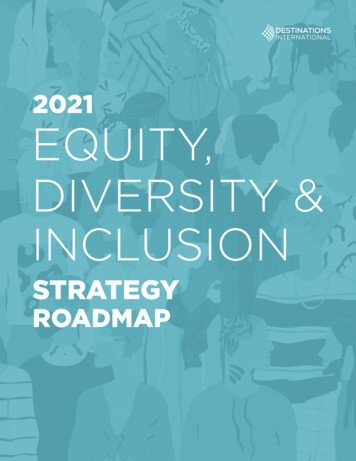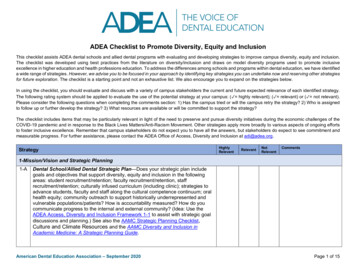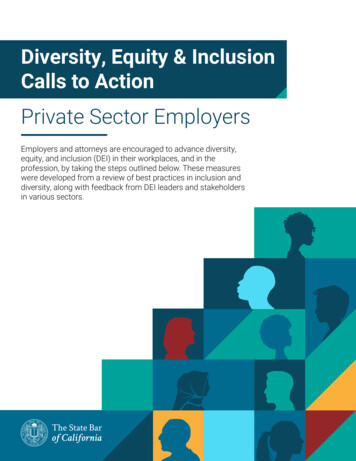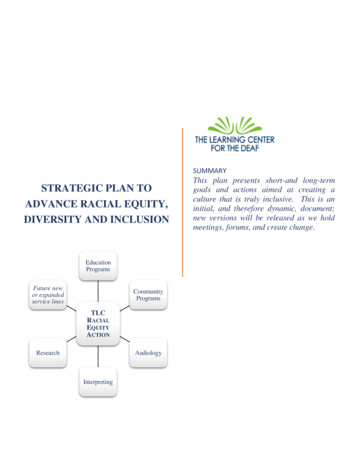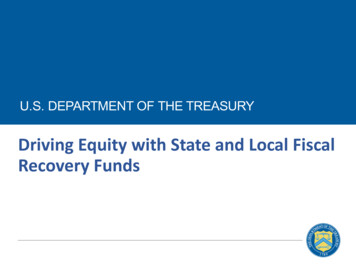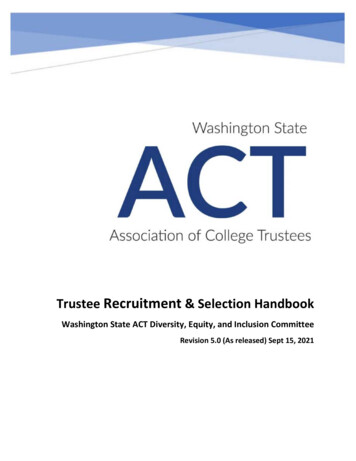
Transcription
Trustee Recruitment & Selection HandbookWashington State ACT Diversity, Equity, and Inclusion CommitteeRevision 5.0 (As released) Sept 15, 2021
TABLE OF CONTENTSIntroduction & Context . 3 Overview of this handbook.More on Becoming a Community College Trustee . 5 General obligations, necessary skills, and attributes expected of Trustees.Timeline . 7 Annual recruitment and selection timeline including roles, responsibilities, and supporting resources.Board Matrix . 11 Example template for boards to proactively and intentionally consider their composition.Page 2 of 13
IntroductionAppointed by the Governor, District Boards of Trustees play an important role in support of the mission of theircolleges and the communities they serve. A pipeline of qualified Trustee applicants, prepared to serve, is essentialto the appointment process. While not prescriptive, this Handbook provides an overview of best practices forBoards of Trustees to support that process through intentional needs assessment, and equitable outreach andrecruitment. This, combined with thoughtful selection by the Governor's office, helps to ensure that new Trustees,and the Boards they join, are set up for success from the very beginning.The handbook is divided into three sections: An overview of the statutory obligations, necessary skills, and attributes expected of Trustees. This, alongwith any local practices, is important information to share with any prospective applicant. An annual calendar describing roles, ownership, timing, and supporting resources for needs assessment,recruitment, application support, selection by the Governor's office, announcement of new Trustees, andthe transition into onboarding. While this is a typical calendar based on October 1 start dates, mid-termdepartures of sitting Trustees may occur due to changes in personal or other situations. Also, interestedapplicants may apply to the Governor's office at any time throughout the year. Boards are advised to adaptthis tool accordingly. An example template for boards to intentionally consider their current and possible future compositionacross various attributes important in reflecting the students and community they serve. This is an exampleonly, intended to be adapted to best serve local needs.Important Context Leading to The Creation of This HandbookWe acknowledge that Racial Disparities in Student Achievement Jeopardize the Mission of the State’s CollegeSystemWashington’s Community and Technical Colleges mission, individually and as a System, is to enable “Better Jobs,Brighter Futures, a Stronger Washington”. Significant and persistent racial disparities in student achievement andemployee retention, often with systemic roots, jeopardizes this mission for everyone.We believe that Leadership Is Essential to Accelerating Progress“Leading with racial equity, our colleges maximize student potential and transform lives within a culture ofbelonging that advances racial, social, and economic justice in services to our diverse communities.” Progress canonly happen if there is a deep appreciation across trustees, presidents, faculty, and staff for changes taking place ineach of our communities, and an urgency around creating an intentional culture of antiracism* as demonstratedthrough policies and practices.We recognize that Trustees Play a Significant Role However Are Not Consistently Equipped for SuccessTrustees play a vital role in leading with racial equity, however today they operate within a legacy framework ofSystem-wide and local culture, policies, and practices that have not been consistently designed with an equitylens**. Efforts to address this are taking place at different rates, oftenindependently, at each of our colleges.Page 3 of 13
We Resolve to Strengthen Trustee Leadership by Re-envisioning the “Lifecycle” of Trustees Through an EquityLensClarify the role, support individual trustees and boards, and create accountability for their part in accelerating localand System wide progress in eliminating racial disparities in student achievement and employee retention.Using an Antiracist Lens, We Envision a Trustee Recruitment and Selection Process That Role Models BestPractices in Equitable and Transparent Hiring, including:o Consistent position description reflecting expectations and qualificationso Equitable recruitment practiceso Equitable application practiceso Equitable selection practicesAntiracism, Antiracist lens: The intentional practice of taking action to interrupt systemic bias contributing todisparities in equitable outcomes across race.*Equity, Equity lens: The intentional data-based process of examining institutional assumptions, culture, values,policy, practices, programs, and systems (physical, informational, social) to understand how they may createbarriers and/or contribute to disparities in outcomes between groups.**Page 4 of 13
More On Becoming a Community College TrusteeTrustee applicants, the boards and colleges they join, and the students and communities they serve are bestsituated for success with an early and clear understanding of the role and expectations of the position.Appointment to a governance board of a state institution is a great honor, brings with it great responsibility, andmay be unlike any board the applicant has ever been a part of.While each community and technical college will have its own unique goals, strategies, policies, practices, andcommunity context there are some common expectations across the system that all Trustees share. In addition tothe following, Boards are advised to share their local district board policies and practices handbook, and othersupporting documents, for specific duties and expectations with board prospects considering application. (SeeApril/May/June resources in the recruitment timeline section that follows.)Boards of Trustees and the Trustees that comprise them, are described in the Revised Code of Washington, RCW28B.50.100:"Boards of trustees – Generally.There is hereby created a board of trustees for each college district as set forth in this chapter. Each boardof trustees shall be composed of five trustees, except as provided in RCW 28B.50.102, who shall be appointed bythe governor for terms commencing October 1st of the year in which appointed. In making such appointments, thegovernor shall give consideration to geographical diversity, and representing labor, business, women, and racialand ethnic minorities, in the membership of the boards of trustees. The boards of trustees for districts containingtechnical colleges shall include at least one member from business and one member from labor.The successors of the trustees initially appointed shall be appointed by the governor to serve for a term offive years except that any person appointed to fill a vacancy occurring prior to the expiration of any term shall beappointed only for the remainder of the term. Each member shall serve until a successor is appointed and qualified.Every trustee shall be a resident and qualified elector of the college district. No trustee may be an employeeof the community and technical college system, a member of the board of directors of any school district, or amember of the governing board of any public or private educational institution.Each board of trustees shall organize itself by electing a chair from its members. The board shall adopt aseal and may adopt such bylaws, rules, and regulations as it deems necessary for its own government. Threemembers of the board shall constitute a quorum, but a lesser number may adjourn from time to time and maycompel the attendance of absent members in such manner as prescribed in its bylaws, rules, or regulations. Thedistrict president, or if there be none, the president of the college, shall serve as, or may designate another personto serve as, the secretary of the board, who shall not be deemed to be a member of the board.Each board of trustees shall follow procedures for open public meetings in chapter 42.30 RCW. Each boardshall provide time for public comment at each meeting.Members of the boards of trustees may be removed for misconduct or malfeasance in office in the mannerprovided by RCW 28B.10.500."Trustees are individually accountable for compliance with requirements of Ethics in Public Service RCW 42.52.Trustees are individually required for annual compliance with requirements of RCW 42.17A.710 F1 Statement ofFinancial Affairs.Page 5 of 13
In order to effectively contribute to both local and system wide goals in service to students and the community,Board members are expected to demonstrate the following skills and attributes. More information can be foundat ee-resources.aspx.Lead with Racial EquityIn doing so our colleges maximize student potential and transform lives within a culture of belonging that advancesracial, social, and economic justice in services to our diverse communities. Progress can only happen if there is adeep appreciation across trustees, presidents, faculty, and staff for changes taking place in each of ourcommunities, and an urgency around creating an intentional culture of antiracism as demonstrated throughpolicies and practices.Know the community needs and trendsGood trustees are connected to the community. They should be aware of the business and economic dynamicswithin the college district and bring a perspective to the board that reflects the needs of the college’s service area.Commit time and effortThe responsibilities of being a trustee extend far beyond one meeting a month. Trustees need to have theflexibility – and the commitment – to dedicate the time it takes to attend college functions, to study boardmaterials, to participate in committees, and to attend training sessions so they can be informed about the local,state and national trends impacting higher education. Over the course of their appointments, trustees should bewilling to commit to continuing professional development locally, through the Washington State Association ofCollege Trustees (ACT), and nationally through the Association of Community College Trustees (ACCT).Be proactive, visionary and future-orientedTrustees need to be able to concentrate on policy issues and to set a vision for the future for the college – where itneeds to be in 10 or 15-years. Trustees need to set goals to help the college achieve that vision. Trustees shouldnot get into the “how” of achieving the goals – that is the domain of the president and staff.Be willing to advocate for the college and its studentsMost trustees accept their appointment to a board with a general understanding of their policy governance role,but another responsibility is to serve as a strong advocate at the local, state and national levels for their collegeand the system.Demonstrate the ability to be a team playerA good trustee is one who has a history working well as part of a team. The power of a board rests with theappointed members acting together, not as individuals. A trustee needs to be willing to work cooperatively tohelp the board reach consensus and then support the decisions of the board.Be committed to the college and serving the public goodA valuable trustee is committed to the role the college plays in the community and is committed to working for thegood of the college and the students. A trustee should not join a board with a personal agenda or for personalgain.Be an ethical, respected leaderTrustees set the standard for ethical and professional conduct. A trustee’s reputation will reflect on a college. Atrustee should be someone who has earned the respect and trust of those who know and work with that individualand someone who will enhance the standing of the college within the community.Page 6 of 13
Typical Trustee Recruitment Timeline (*)Consistent with Open PubicMeeting rules the boarddelegates 2 Trustees towork with the President asa Recruitment Committee.Members are selectedalong with other committeeappointments per localtiming and practice,typically in Aug/Sept.To update board matrixand review priority needsof the board consideringdistrict strategies andcurrent boardcomposition.With President, recruitingCommittee identifiespriority needs of the collegefor future BOT members.To inform communityoutreach and courtesyconversations withprospective applicants.Recruitment committeecommunicates expectedopening and district priorityneeds to Governor's office.Ensure that positionopening is equitably andbroadly communicatedBy WhomJanuaryFebruaryMarchPage 7 of 13XHow (Resources/Methods/Actions)Trustee ProspectWhyCollege DistrictBest PracticeGovernor's OfficeWhenDistrict Mission/Strategies/ValuesDistrict and College demographicsDistrict Board Policies, Procedures and/or HandbookBoard MatrixRecruitment Committee to have completed Unconscious BiasTraining and Equity in Hiring Training within the previous twoyears. Boards are advised to work through their District President toaccess training material from their College's Diversity, Equity, andInclusion team. If material is not locally available boards are advisedto contact Ha T. Nguyen, Director Equity, Diversity, & Inclusion, WAState Board for Community and Technical Colleges(hnguyen@sbctc.edu, 360-704-1001) to identify additional options.Recruitment Committee should also be familiar with RCW49.60.400 (I-200) and the federal Equal Protection Clause - contactyour assigned District Assistant Attorney General for moreinformation.X
This is not a list of names,rather, attributes.to all communities thatthe district serves.Advertise on state systemsand publicationsOpening promoted locallyAprilMayJuneCourtesy conversationstake place betweenRecruitment Committeeand candidate prospects.Note that while bestpractices for interviewsshould be utilized, theseare NOT actual interviews.Additional Note: The Gov’soffice has sole authorityand discretion in -opportunitiesXTo ensure that prospectsunderstand expectationsof the role, timecommitment, needs ofthe district, andapplication process steps.XXDistrict jobs page, social media, word of mouth, to local legislators.XBoards are advised to provide candidate prospects with access tothe following resources:District Mission/Strategies/ValuesDistrict Board Policies, Procedures and/or usteeresources.aspxRCW 42.52 Ethics in Public ServiceRCW 42.17A.710 F1 Statement of Financial AffairsLEGAL OBLIGATIONS OF COLLEGE & UNIVERSITY TRUSTEES: AReference Guide for New Trustees. H. Bruce Marvin, AAG EdDivision, August 2019 or current revision available from yourassigned District Assistant Attorney General.Page 8 of 13
JulyAugustProspects CompleteApplication with navigationsupport from recruitmentcommittee and Governor'soffice. Application can takeplace at any time, howevertypically after local courtesyconversations in April-Junetimeframe.To ensure prospects aresuccessful in submitting acomplete application.XRecruitment committeeconfers with Governor'sofficeTo provide any additionalinformation to supportGovernor's officeapplication due diligence.XGovernor's office completes To identify and selectdue diligence andnew district BOTinterviews with 3 member.applicantsSeptember Announce selectedapplicantSo that there is statewidevisibilitySo that there is districtlevel visibilityOctoberPage 9 of 1330 Day onboarding reviewXXXIndividuals conducting due diligence, interviews, and selection ofapplicants to have completed Unconscious Bias Training and Equityin Hiring Training within the previous two years. Such individualsshould also be familiar with RCW 49.60.400 (I-200) and the federalEqual Protection Clause - contact the state Attorney General's officefor more ofilesXDistrict web page, social media, media, Board meeting, etc.XTo ensure a smoothtransition to an endation-form/Term BeginsBoard peer mentorassigned and ut/trustees/ntochecklist-90.pdf
and satisfying term asTrusteeDecemberTo ensure a smoothXX ustees/ntotransition to an effectiveroadmap.pdfand satisfying term asTrustee(*) Note: This is a typical timeline for normal board terms beginning October 1. However, prospects may apply at any time throughout the year. Also, from timeto-time mid-term openings may occur due to the early departure of a sitting Trustee.Page 10 of 1390 Day and ongoingonboarding reviews
Example Board Matrix (1/3)Note: This is an example for boards to intentionally consider their current and possible future composition across various attributes important in reflecting thestudents and community they serve. Board matrices are intended to be adapted to best serve local needs, self-disclosed, and not a requirement. Board matricesare for district internal use only, not to be shared with the Governor's office responsible for final selection, and subject to legally allowed public disclosure.Board Members ProfileCollegeStudent ProfileDistrictDemographics(SBCTC FieldGuide)(www.census.gov)Board Officer and Committee ExperienceBoard TermsBegan Term 1 (dd/mm/yyyy)End Term 1 (dd/mm/yyyy)Began Term 2 (dd/mm/yyyy)End Term 2 (dd/mm/yyyy)Example Committee Service (past or current)ChairVice ChairStrategy CommiLegislative Action CommitteeFoundation (Rep #1)Foundation (Rep #2)Board Budget CommitteeFacilities Master PlanWA ACT DEI CommitteeGuided PathwaysBOT Recruiting CommitteeStrategy CommitteePresidential SearchPresidental OnboardingOther Committees per local practicePage 11 of 13Trustee 1Trustee 2Trustee 3Trustee 4Trustee 5StudentTrustee
Example Board Matrix (2/3)CollegeStudent ProfileDistrict(SBCTC FieldDemographicsGuide)(www.census.gov)Trustee 1Trustee 2Trustee 3 Trustee 4Board Demographics (Utilized to help ensure a well represented board reflecting the students and community the district serves)How do you identify? (Check all that apply)Female%%Male%%NonbinaryTransgenderGender DiverseGayLesbianBisexualOtherPrefer Not to AnswerRace/Ethnicity (Check all that apply)American Indian or Alaska NativeAsianBlack or African AmericanHispanic/LatinoNative Hawaiian or other Pacific IslanderWhiteMixed raceIdentifies Systemically Non-dominant(Race, gender identity, disability, or sexual orientation)%%%%%%%%%%%%%%Age CohortGeneration Alpha: Born 2013 Generation Z: Born 1997-2012Millennial: Born 1981-1996Generation X: Born 1965-1980Boomer: Born 1946-1964Silent Generation: Born 1928-1945Home GeographyDistrict Subgeography 1District Subgeography 2District Subgeography 3District Subgeography 4District Subgeography 5Lived or Worked Abroad? (Y/N)Multilingual ? (specific)Page 12 of 13(median)(median)Trustee 5StudentTrustee
Example Board Matrix (3/3)CollegeStudent ProfileDistrictDemographics(SBCTC Field(www.census.gov)Guide)Academic BackgroundPast District K-12 Student? (Y/N)Past District College Student? (Y/N)Past Community College Student? (Y/N)Academic Degree(s)First Gen? (Y/N)%Professional ExperienceWork StatusWorking FTWorking PTRetiredVolunteer(Prof)esional Fields and/or Community (Network)s in College Areas of StudyAdvanced Manufacturing and MechanicalBusiness and EntrepreneurshipCreative and Communcation ArtsHealth Care and BiosciencesPublic Service, Society, and EducationScience, Technology, and EngineeringOther (ex: Judicial/criminal justice, DEI,Government, Public Relations, Marketing, etc)Job Sector Work ExperienceFor Profit ry (Veteran)Foundation ExperienceFaculty ExperienceGuest Lecturer ExperienceElected ExperienceNon-College Board ExperiencePage 13 of 13Trustee 1Trustee 2Trustee 3Trustee 4Trustee 5StudentTrustee
3 of 13. Introduction Appointed by the Governor, District Boards of Trustees play an important role in support of the mission of their colleges and the communities they serve. A pipeline of qualified Trustee applicants, prepared to serve, is essential to the appointment process.
